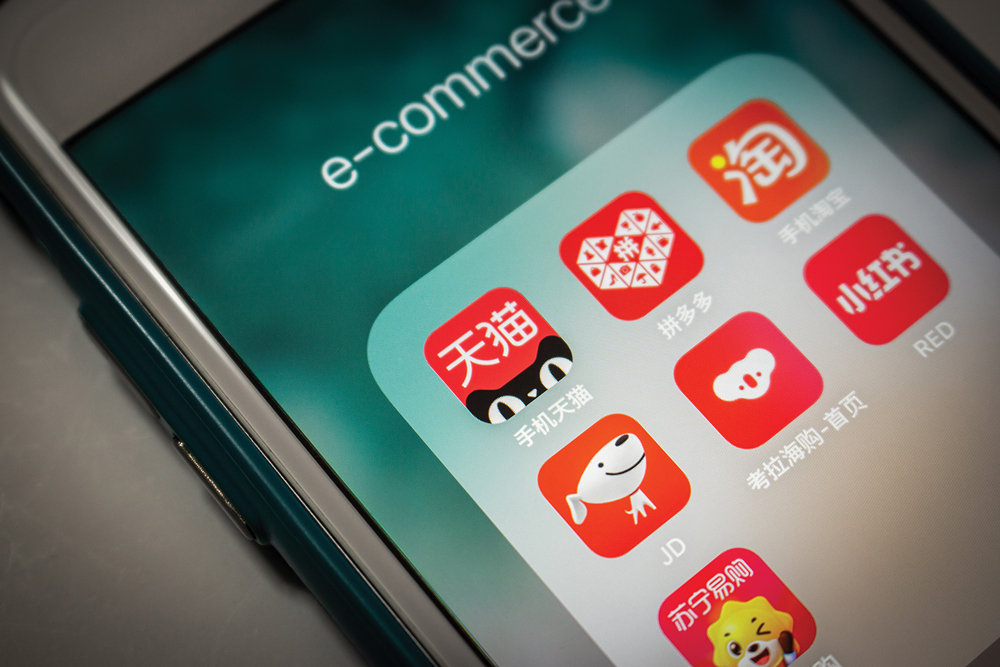
China is arguably the first country in the world to get to the point where everything can be found and purchased online. Whether it’s a product or gig-economy services, you can log on to an app and find anything at any time. The country is the most e-commerce-intensive economy in the world, with e-commerce accounting for over 50% of total retail spending in China in 2021, compared to only 13.9% in the US.
Online shopping platforms, such as Alibaba’s Tmall and JD.com, are ubiquitous in China and standardized to a degree that reduces the cost and complexity of setting up a shop to a minimum. Admittedly, it is probably not radically different in cost and complexity than setting up on Amazon in the US, but given the size of the Chinese market, the potential for profit in China is unmatched for foreign as well as Chinese companies.
Unsurprisingly, the scale and level of access on offer to individual consumers in every corner of China have led to a considerable number of small- or mid-tier brands from around the world looking to jump into the market. While the act of setting up shop in the market may be simple, there are several issues for a company to consider when shifting from the standard model in its home country, which is bricks and mortar with e-commerce on the side, to China where it is a core pillar of business strategy.
Understanding the landscape
In 2012, there were around 242 million online shoppers in China, but the two largest e-commerce platforms, Tmall and Taobao, both owned by Alibaba, now have around a billion monthly active users. B2C e-commerce sales in China are expected to surpass $1.5 trillion in 2022, with the two Alibaba apps accounting for over 60% of the sales volume. JD.com, which started with a more tech-related set of offerings but now offers a wide range of consumer goods, makes up another 30% of China’s e-commerce sales.
But while e-commerce is somewhat of a duopoly, there is no limit to the number of companies that can register to sell their products through those platforms. Around 150,000 vendors are registered on Tmall, and 30,000 international brands are selling into the China market through its sister Tmall Global.
How did China get here?
Much of the original technology behind e-commerce originated outside of China, but there has been something of a leapfrog dynamic in play, with Chinese companies enhancing various concepts such as online payments and QR codes to create the all-encompassing e-commerce platforms that operate in the country today.
Following World War II, the US and other Western markets developed the basic framework of pre-digital consumer retail, including chain stores and shopping malls. This resulted in the development of national retail distribution systems which were very efficient at supplying the mass market.
With that infrastructure already in place, including the existence of plastic credit and debit cards, e-commerce was slow to add value because there was already a means to access what you wanted quickly and simply. Only over time was e-commerce able to get some traction through offering specialty goods or niche items that were less readily available at local shopping malls—Amazon’s books are a good example. China never developed any of this infrastructure to any extent, and so avoided a range of legacy issues and was in a position to leapfrog these Western markets.
The country did, however, have to overcome the prevalence of counterfeit goods. Tmall has done a particularly good job in maintaining brand integrity and authenticity, as you may only sell on the platform if you are the brand owner or an authorized agent. You can still find black or gray market goods in China, but one of the reasons Tmall does so well is that it only sells these authentic products.
Although traditional online vendor-to-consumer transactions are still the dominant model, the big change in the industry over the last two or three years has been the emergence of social commerce, where you can chat with others and get involved with the brands, and can purchase at the same time. There is now a greater mixture of shopping and entertainment, with people going online for news, to connect with people, and to be entertained.
These are dimensions of commercial behavior that the major e-commerce platforms don’t fully account for yet, and this is why we have seen a rise in popularity in other apps such as Pinduoduo and Xiaohongshu, which offer a combination of social media, entertainment, live streaming and e-commerce.
Entering the market
For foreign firms looking to enter China’s e-commerce market, it is no longer a geographical question of where to set up shop, the real challenge is more strategic. Most international businesses have only ever grown organically, meaning they just do what they did the year before but on a slightly larger scale—perhaps selling $30 million in product one year, and aiming for $35-$40 million the next. That was the successful approach and the entire DNA of these companies was oriented toward that organic growth model.
Entering China, you have to think about strategic growth instead. This means it is necessary to have an ad campaign that runs well ahead of sales. It’s an investment that goes against the regular practice of calibrating ad spending against sales revenue, but without the brand recognition and word-of-mouth in your home market, it’s a necessary step.
For several years, your ad spend and your ad spend ratio in China will be worse than it is in your home market because all of the strengths that bolster your ad spend at home don’t exist in this new market. Strategic development is a priority and requires something like a three-year budget for China, which maps out spending and sales projections well in advance.
This is nothing new for big conglomerates such as Unilever which bring 20 new brands into China every year. They might give each of these brands a $3 million launch budget to raise awareness ahead of a sales launch. But this is a completely new approach for smaller brands, which might not even have the cash for such a budget. The biggest challenge in launching in the China market is being prepared to take a leap of faith and investing in an ad campaign upfront.

Prospects for foreign firms
The good news is that Chinese consumers are affluent, curious and quite comfortable with international goods. When you show up, they’re receptive, open and willing to partake in whatever you are offering. The challenge stems from the fact that China is not only the largest but arguably the most competitive retail market in the world.
There are several differentiating factors in China because of the digitally driven nature of the market, and one of them is that there is a premium on differentiation due to market size, and also on good communication and clear narrative strategy. Some brands have handled this well, but others are much weaker in that regard.
Many of the weaker brands tend to be those that have a dominant position in their home market, simply through longevity or because they were the first mover. They have never really had to do an extraordinary job of communicating with consumers, because of their ubiquity and strong legacy. This is something to respect, but when moving to a new country, it is not something you can rely on. You now have to explain yourself and explain your value proposition to people who didn’t grow up with you and your products from childhood.
Take a company selling peanut butter that I worked with as an example. Everybody in the United States grew up with peanut butter, it’s a common kitchen condiment and is pretty much found in any household. In China, on the other hand, nobody grew up with peanut butter even though peanuts are certainly an established part of the Chinese diet. This means that the company bringing the product into the country has to explain to the Chinese consumer why it is there and what it can do for them. Is it healthy food? Is it nutritious? Is it part of an affordable lunch?
But because of the ubiquity of peanut butter in the US, the brand had never actually had to answer these questions before. Courting the customer and explaining yourself in China requires more thought than many people assume.
Succeeding in the market
A lot of new companies end up dissatisfied after a year or two in the China market, but the main reason is that they did not define what a successful year would look like before entering the market. What are the gross sales, net profit, market share, or growth rate targets to be set? But then, perhaps the correct goals are none of those and what you should be doing is measuring your success in China relative to the whole market, or relative to your domestic competition. Pepsi, for example, would want to make sure they are not being entirely cleaned out by Coke in the China market.
Every company will have a different answer to this question. For many, the first year will be about breaking even, showing that they can resupply properly and their logistics systems work, building consumer sentiment, and maintaining good ratings on the e-commerce platforms. It’s a preparatory year. If you sell $1 million of product in the first year, that’s respectable and you can step on the gas in year two and push that up to $3-$5 million.
The issue is that a lot of companies don’t necessarily have a consensus on what they deem as success. And that means that say you only sell $500,000 worth of product in your first year, crisis talks might be on the horizon.
But that result could still be considered a success. Yes, you spent a lot of money, and perhaps you lost money in that first year, but establishing a half-million-dollar market in China in 12 months is an impressive feat, and implies that you have traction and that something is working. After that, you get data and feedback, so that you can adjust, modify and recalibrate to build on that initial success. It’s not perfect, but there is a lot of good news in such a picture, as long as you adequately capitalize on it.
Key issues to keep in mind
China’s e-commerce market is remarkably fair, in that there’s no discrimination by consumers against products from different countries. Whatever you are selling, you are going to be going head-to-head not just with indigenous brands, but also with all kinds of international competition. The issue is that all of these brands are saying the same things about their products and so you need to set yourself apart. You might be the top dog in your home country but you could be 99th out of 100 in China. You either need to prove your product is better or find a market segment to serve that isn’t currently being served.
Secondly, to tell a story that engages the customer, you have to be able to connect effectively with consumers through the new digital formats. There are many ways to do this, for example through advertising, the use of celebrities, or gamification, but whichever option you choose, it has to be based on creativity, good communication, and offering something unique. The authenticity provided by live-streaming demonstrations from your own country is a good example.
The biggest single mistake that foreign brands in China can make is to do nothing different. They don’t look at the market, they don’t adapt the product or adapt their messaging. There are some attributes of Chinese consumers that are going to be similar to those in your home market, but there are also many others that are different. Chinese consumers might enjoy different flavors or colors, and if purchasing power is high, then perhaps you would want to emphasize your mid-range products over the higher-end. You need to think through how you are behaving in this market to reach as many consumers as you can.
Take China’s growing coffee market. Consumption is growing rapidly, but per capita consumption is still lower than in Western markets—per capita, Chinese people drink around four cups of coffee a year. Because of this, it is very unlikely that the average home in China will have a coffee maker. With less regular consumption and a lack of coffee machines in homes, there is a much greater skew towards instant coffee or single-serve sachets, compared to beans or ground coffee.

The future of e-commerce
In every country in the world, and every consumer segment, e-commerce continues to gain market share. China has a more robust e-commerce ecosystem than anywhere else, but other countries are going down the same path. Globally, we see a leap in pure-play e-commerce brands, the rise of social commerce, same-day delivery and other aspects of the digital economy that were pioneered or came to maturity in China.
For China specifically, as with all things related to China’s economy, predictions for the future are difficult. But a few things seem clear. There will be an evolution of social commerce and these other attributes, meaning the pure traditional play e-commerce platforms like Tmall will see slower growth, whereas there will be more rapid growth of the social commerce platforms like Douyin. The same is true of gamification channels. If you’re buying regularly in China, you almost certainly want something more than just a transaction platform, you’re looking for a social dimension or a conversation, or some sort of augmented reality or virtual reality to keep you stimulated.
There is now a reasonable awareness and understanding of the China market amongst foreign companies. Some people know it’s bigger than the US, but there is a big language gap and a big cultural gap in terms of setting up and being successful. So that is a little bit intimidating for many companies. The key is home-country brand management and integrity and China execution. Then you have the best of both worlds.
Frank Lavin is the CEO of Export Now, a company dedicated to helping consumer brands sell their products in China. Previously he headed the International Trade Administration for the United States Department of Commerce and served as the US Ambassador to Singapore. He is the author of The Smart Business Guide to China E-Commerce.




















